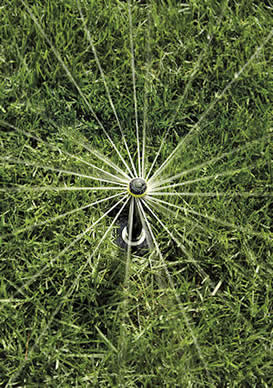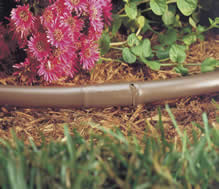Water Conservation Tips
 Water conservation is achieved through using water efficiently -- in the most precise and even manner possible, minimizing waste. The following tips contain a number of best practices and suggestions that can be used to manage water more efficiently in your irrigation system.
Water conservation is achieved through using water efficiently -- in the most precise and even manner possible, minimizing waste. The following tips contain a number of best practices and suggestions that can be used to manage water more efficiently in your irrigation system.
1. Use water conservation products to promote water and cost savings.
Water conservation products are better for the environment AND they can save money. While water conservation products may be more expensive to purchase, they will save you money in the long run.
2. Design for different plant needs and environmental conditions.
Set up irrigation zones and schedules for plants based on the water needs of your landscaping. This might require more zones and may cost more initially but will save water in the long run. For example, suppose a landscape includes grass, shrubs, and trees, and the grass requires more water to stay healthy than do the shrubs and trees. If everything is on the same zone, the watering needs will be dictated by the grass, and the shrubs and tress will be over-watered. With separate zones controlled by separate programs on a controller, you can divide the schedule into smaller, more precise watering times and apply on the water needed for the particular plant.
3. Use pressure regulating devices in high pressure situations.
Every 5 psi reduction in water pressure reduces water usage by 6-8%. The savings are over 50% if a 70 psi spray zone is reduced to the recommended 30 psi. So, design for an optimum 30 psi water delivery to spray heads to avoid wasteful misting/fogging. This can be achieved with pressure regulating spray heads, pressure reducing valves, and pressure regulating modules installed on valves. For low pressure situations which can result in uneven coverage, use a high efficiency pump.
4. Use check valve devices to prevent low head drainage
In landscaping with different elevations, water flows down to the lowest head on the system and drains out, causing puddling, erosion, and run-off. A check valve or pre-installed Seal-A-Matic™ (SAM) device prevents the water from draining out by trapping the water in the lateral line.
5. Use high efficiency nozzles for uniform coverage
Use nozzles that apply water evenly and save up to 30% in water usage. This is best achieved using matched precipitation rate nozzles . If precipitation is not matched, the system must be set to water the area that is putting down the least amount of water, thereby over-watering the other areas and wasting water. High efficiency nozzles are matched precipitation nozzles that provide the best and most uniform coverage, thereby eliminating watering gaps and reducing water usage…by as much as 30%.
 6. Install direct-to-plant-root irrigation in non-turf areas
6. Install direct-to-plant-root irrigation in non-turf areas
Use drip irrigation for shrubs, flowers, and other non-turf areas. Drip irrigation systems deliver precise amounts of water slowly and evenly at the plant’s roots, eliminating water waste, run-off and over spray onto windows, walks and streets. The slow, consistent application of water at the plant root reduces weeds and plant disease, and helps plants to thrive.
7. Use flow control devices
Install valves with flow control that allow you to better manage the flow of your system and prevent run-off .
8. Use an automatic shut-off device on every system
Adding an automatic shut-off device can result in 15-20% in water savings. Install an automatic shut-off device like a rain sensor or moisture sensor on every system. These devices automatically shut-off the controller when it is raining or when sufficient soil moisture is reached. They prevent over-watering and the bad publicity that results from sprinklers running when it rains.
9. Switch to an automatic controller with water-conserving functions
The following are some of the key features currently available in controllers for maximum flexibility and water efficiency:
- Multiple start times – allows several shorter and more precise run times to prevent run-off and puddles.
- Multiple independent programs – allow the watering schedule to be divided into smaller, more precise watering schedules to accommodate the watering needs of different types of plant life.
- Water Budget - provides easy and flexible adjustments to the amount of water used for irrigation.
- Rain Delay – allows the user to pause a watering schedule when irrigation isn’t needed and resume watering when appropriate.
- Flow Management – enables the controller to detect system problems like line breaks or broken sprinklers and shuts down irrigation to the affected zones to prevent water waste.
- ET Programming – enables the controller to calculate daily evapotranspiration (ET) values and adjust the station run times to replace only the water used by the plants. This maintains a healthy landscape while minimizing water use.
10. For complete system automation on commercial sites, consider a central control system
Central control systems show annual water savings of 25 – 30% on average. A central control system operates a single or multiple controllers, sensors and other irrigation devices from one central location. It contains all of the functions listed in the Controller section above plus additional sensors that monitor and control environmental conditions…automatically and without the need for personal intervention.
11. Set sprinklers to water early in the morning
Set up systems to irrigate between 5 a.m. and 10 a.m. Early in the morning is the most efficient time to water because water can reach its destination without being evaporated by the sun or blown away by the wind. This will also save landscapes from disease caused by water sitting on plants overnight and prevents compaction caused by heavy traffic on wet soils.
